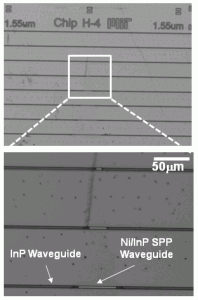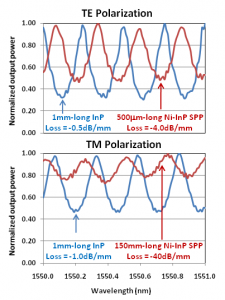Hybrid Plasmonic Waveguides
Surface plasmon polaritons (SPP) that propagate at the interface between metals and dielectrics permit strong optical-mode confinement and are therefore potentially useful for realizing compact waveguide devices [1]. In particular, the strong interaction of the SPP optical mode with the metal guiding layer may be exploited in lossy metals to realize compact polarizers, or in ferromagnetic materials to produce large non-reciprocal absorption and phase shift for use in optical isolators [2].
In this work, we demonstrate hybrid Ni-InP SPP waveguides that have been integrated with low-loss InP waveguides to achieve polarizers with high polarization extinction in the fiber optic c- and l-bands (1530 nm-1625 nm). The devices are fabricated using a self-aligned process, in which a patterned nickel layer is used as an etch mask for both the low-loss InP and polarizing hybrid plasmonic waveguides. The nickel is first patterned, then the InP is dry-etched, and finally the nickel is selectively removed from portions of the top of the InP waveguide to create low-loss waveguides. A microscopic image of the fabricated waveguide test structures is shown in Figure 1. Compared to other metals, nickel offers the advantages of good adhesion with InP and large loss for the transverse magnetic (TM) mode relative to the transverse electric (TE) mode. Fabry-Perot cavity measurements, shown in Figure 2, demonstrate -4dB/mm of loss for the hybrid TE mode compared to -40dB/mm of loss for the hybrid TM mode, giving an overall polarization extinction of -36dB/mm. Further improvements in polarization extinction may be obtained by strengthening the coupling of the dielectric to the lossy Ni-InP SPP, or by incorporating intermediate low-loss SPP stages to improve the coupling efficiency. Future work will be directed towards this goal and to the inclusion of magneto-optic SPPs for use as optical isolators.
- Figure 1: Microscopic images of the fabricated InP and Ni-InP SPP waveguide polarizers. The Ni acts as an etch mask for the InP and is then selectively removed in areas to produce low-loss polarization-insensitive InP waveguides coupled to TE polarizing Ni-InP SPP waveguides.
- Figure 2: Fabry-Perot measurements of the InP and Ni-InP SPP waveguides. (top) TE polarization measurements show InP waveguide loss of -0.5dB/mm and Ni-InP SPP loss of -4.0dB/mm. (bottom) TM polarization measurements show InP waveguide loss of -1.0dB/mm and Ni-InP SPP loss of -40dB/mm. These measurements demonstrate a polarization extinction of -36dB/mm for the SPP polarizers.
References
- S. A. Maier and H. A. Atwater, “Plasmonics: Localization and guiding of electromagnetic energy in metal/dielectric structures,” Journal of Applied Physics, vol. 98, 011101:1-10, July 2005. [↩]
- J. Montoya, K. Parameswaran, J. Hensley, M. Allen, and R. Ram, “Surface plasmon isolator based on nonreciprocal coupling,” Journal of Applied Physics, vol. 106, 023108:1-6, July 2009. [↩]

